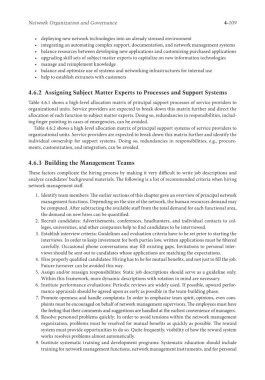Page 578 - Handbook of Modern Telecommunications
P. 578
Network Organization and Governance 4-109
• deploying new network technologies into an already stressed environment
• integrating an automating complex support, documentation, and network management systems
• balance resources between developing new applications and customizing purchased applications
• upgrading skill sets of subject matter experts to capitalize on new information technologies
• manage and reimplement knowledge
• balance and optimize use of systems and networking infrastructures for internal use
• help to establish extranets with customers
4.6.2 Assigning Subject Matter Experts to Processes and Support Systems
Table 4.6.1 shows a high-level allocation matrix of principal support processes of service providers to
organizational units. Service providers are expected to break down this matrix further and direct the
allocation of each function to subject matter experts. Doing so, redundancies in responsibilities, includ-
ing finger pointing in cases of emergencies, can be avoided.
Table 4.6.2 shows a high-level allocation matrix of principal support systems of service providers to
organizational units. Service providers are expected to break down this matrix further and identify the
individual ownership for support systems. Doing so, redundancies in responsibilities, e.g., procure-
ments, customization, and integration, can be avoided.
4.6.3 Building the Management Teams
These factors complicate the hiring process by making it very difficult to write job descriptions and
analyze candidates’ background materials. The following is a list of recommended criteria when hiring
network management staff.
1. Identify team members: The earlier sections of this chapter gave an overview of principal network
management functions. Depending on the size of the network, the human resources demand may
be computed. After subtracting the available staff from the total demand for each functional area,
the demand on new hires can be quantified.
2. Recruit candidates: Advertisements, conferences, headhunters, and individual contacts to col-
leges, universities, and other companies help to find candidates to be interviewed.
3. Establish interview criteria: Guidelines and evaluation criteria have to be set prior to starting the
interviews. In order to keep investment for both parties low, written applications must be filtered
carefully. Occasional phone conversations may fill existing gaps. Invitations to personal inter-
views should be sent out to candidates whose applications are matching the expectations.
4. Hire properly qualified candidates: Hiring has to be for mutual benefits, and not just to fill the job.
Future turnover can be avoided this way.
5. Assign and/or reassign responsibilities: Static job descriptions should serve as a guideline only.
Within this framework, more dynamic descriptions with rotation in mind are necessary.
6. Institute performance evaluations: Periodic reviews are widely used. If possible, upward perfor-
mance appraisals should be agreed upon as early as possible in the team-building phase.
7. Promote openness and handle complaints: In order to emphasize team spirit, opinions, even com-
plaints must be encouraged on behalf of network management supervisors. The employees must have
the feeling that their comments and suggestions are handled at the earliest convenience of managers.
8. Resolve personnel problems quickly: In order to avoid tensions within the network management
organization, problems must be resolved for mutual benefits as quickly as possible. The reward
system must provide opportunities to do so. Quite frequently, visibility of how the reward system
works resolves problems almost automatically.
9. Institute systematic training and development programs: Systematic education should include
training for network management functions, network management instruments, and for personal

